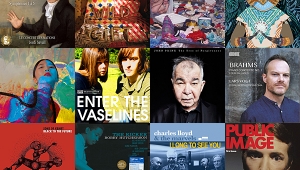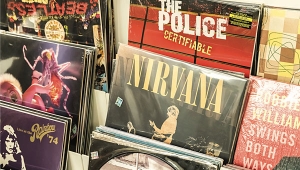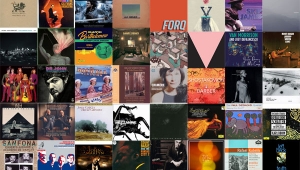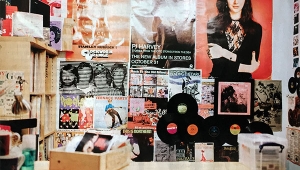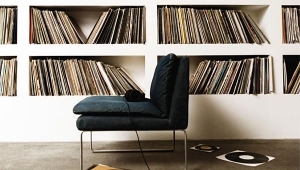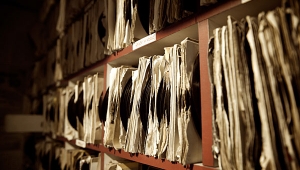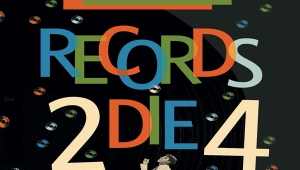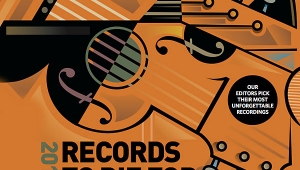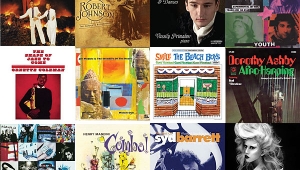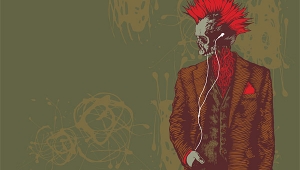| Columns Retired Columns & Blogs |
1991 Records To Die For Page 11
Michael Ross
There's a quote on a King Crimson album that says "Discipline is never an end in itself, only a means to an end." In drawing up a list such as this (arbitrary at best), it should be remembered that neither are "great highs," "tight low end," or "virtually no distortion" ends in themselves---they exist only to serve the music and the vision of the artist. There are probably many albums that make the ones that I have chosen sound primitive by comparison---hiss-free, distortionless, broad-banded marvels of digital technology. But, as we all know, in many cases they are more reflective of an artist's budget than of inherent talent.
BRYAN FERRY: Boys and Girls
Warner Brothers/EG 9 25082-1 (LP), -2 (CD). Rhett Davies, eng.; Rhett Davies, Brian Ferry, prods. AAA/AAD. TT: 38:28
Ennui as art. Ferry and mixmaster Bob Clearmountain construct soundscapes of swirling guitars and percussion that take you into a new world. New, that is, to those of us who are not already jaded aristocrats with a not-so-hidden vulnerable side.
BILL FRISELL: Is That You?
Elektra Musician 9 60956-2 (CD only). Jay Follette, eng.; Wayne Horvitz, prod. ADD. TT: 51:53
For over ten years Bill Frisell has quietly been the most brilliant and unique voice to come along in jazz guitar since Wes Montgomery (imagine Jim Hall meets Jeff Beck). In light of this, it may be easy to overlook the fact that he may also be one of the most promising composers of modern American music on the current scene (are you listening, Kronos?). Is That You? provides what Frisell's previous solo album attempted---an overview of his guitar and compositional genius. In Wayne Horvitz he has found a producer who provides a setting in which this jewel of an artist can shine. Frisell's guitars (and banjo) have never sounded better, and the recording overall is one of the best I have ever heard.
GRACE JONES: Nightclubbing
Island 7 90093-1 (LP), -2 (CD). Alex Sadkin, eng.; Chris Blackwell, Alex Sadkin, prods. AAA/AAD. TT: 38:09
Attitude as art. This is not disco. This is funk meets rock meets cabaret meets reggae meets tango. More world music from the days before anyone talked about world music. Songs by Bill Withers, Iggy Pop, Sting, and Astor Piazzola stand beside Jones's originals without overshadowing them. A perfect marriage of singer and musicians. Thanks to Chris Blackwell for the concept, but garlands to the late Alex Sadkin for defining stereo placement on this and the other two albums that he co-produced for Grace. Under headphones, at times you would swear sound is coming from behind you. CD and LP reveal no discernible difference.
KING CRIMSON: Discipline
Warner Brothers/EG 3629-1 (LP), -2 (CD). Rhett Davies, eng.; King Crimson, Rhett Davies, prods. AAA/AAD. TT: 38:06
If the Beatles did nothing else, they showed us that in rock bands the whole is definitely more than the sum of its parts. The banding together of Adrian Belew, Bill Bruford, Robert Fripp, and Tony Levin in 1981, for three glorious albums, proved it anew. Belew's humor counterbalanced Fripp's, well yes, discipline, and bassist Tony Levin's New York funk added the grease to Bruford's polyrhythms. An all-too-rare example of four virtuosos paying homage to music, not technique. The minimalist production removes any last possibility of pomposity. At first I thought the LP might be deficient in highs, but in the end I find this a plus, as it softens some of the industrial sounds that can be a bit too much on the CD. That is to say, Adrian's elephant guitars sound more like elephants and less like guitars on the LP.
JONI MITCHELL: Hissing of Summer Lawns
Asylum 7E-1051 (LP), -2 (CD). Henry Lewy, eng.; Henry Lewy, Joni Mitchell, prods. AAA/AAD. TT: 42:40
A critical whipping boy (girl?) when it was released, this remains my favorite Joni album. It was here that she pushed her songwriting to its natural limits (later attempts sound forced). On this record she meets jazz on her own turf and comes out on top, as opposed to later experiments where her ambitions seemed to overwhelm her.
BEETHOVEN: The Nine Symphonies
Herbert von Karajan, Berlin Philharmonic; in Symphony 9: Gundula Janowitz, soprano; Hilde Rossel-Majdan, contralto; Waldemar Kmentt, tenor; Walter Berry, baritone; Wiener Singverein
DG 429 036-2 (5 CDs only). Günter Hermanns, eng.; Otto Gerdes, Hans Otto Wohlert, prods. ADD. TT: 5:32:33
I hope the CDphobes have the vinyl original of this 1963 cycle in good shape. For the rest of us, DG has done an excellent transfer of naturally produced analog recordings before DG and Karajan went mad at the mixing consoles. The productions match the consistent approach of the performances. Karajan's classical, mostly-faithful-to-the-letter view of the cycle bears his distinctive imprint, while sparing us his more overbearing mannerisms. The playing of the Berlin Philharmonic epitomizes the sound of Beethoven in a way that period instruments never will. This set remains the post-WWII Beethoven Symphony statement on recording.
RAVEL: Daphnis et Chloe
New England Conservatory/Alumni Choruses, Robert Shaw, dir.; Boston Symphony, Charles Munch
RCA LSC 1838 or Chesky RC 15 (LPs only). AAA. TT: 54:17
Digiphobes rejoice. Choose the Chesky and it's a current all-analog vinyl treasure. Chesky or original RCA, this remains the Daphnis for all reasons. Monteux/LSO on Decca/London CD is almost too close to call, and the new Haitink/BSO on Philips is practically the only recent recording that can look Munch in the eye---but Haitink will blink first. Munch/BSO has it all down. The manic, the exotic, the obsessed, the erotic, all with the unique individual colorations of an orchestra of eccentric, sometimes even weird stylists, all well prior to Ozawa gentrification. And the sound to match. (XII-8)
SHOSTAKOVICH: Symphonies 1 & 7
Leonard Bernstein, Chicago Symphony
DG 427 632-2 (2 CDs only). Hanno Rinke, exec. prod.; Hans Weber, prod.; Karl-August Naegler, eng. DDD. TT: 119:53
A recording that sounds more like the real Chicago Symphony really sounds than almost any recording since the Martinon/CSO Varèse Arcana/Martin Concerto for 7 Winds of 1966 in pre-renovation Orchestra Hall for RCA. For preserving the live performances of Leonard Bernstein's first CSO appearances in more than 30 years, and for doing so in a totally honest audio production in the dry, unforgiving acoustics of today's Orchestra Hall, all's forgiven, DG. (XIII-4)
R. STRAUSS: Scenes from Elektra and Salome
Inge Borkh, soprano; Frances Yeend, soprano; Paul Schoeffler, baritone; Chicago Lyric Theatre Chorus, Chicago Symphonym, Fritz Reiner
RCA 5603-2-RC (CD only). Leslie Chase, Lewis Layton, engs.; John Pfeiffer, Richard Mohr, prods. ADD. TT: 67:04
If RCA had recorded Elektra complete with these forces, it could have joined the Callas/Da Sabata Tosca as the "other" most perfect opera recording ever made. As it is, these excerpts offer a compelling reminder of what dramatic singing, potent conducting, great orchestral playing, and natural stereo miking could produce during the 1950s. All contents on this CD derive from two-channel 30ips masters. Channels are reversed in the Recognition Scene. Otherwise the CD version is a technical triumph. Salome's Dance, which derives from RCA's first stereo sessions in 1954, has never had the present degrees of clarity or dynamic range on previous stereo vinyl issues. This CD is absolutely guaranteed to leave you limp and exhausted, but not from listening fatigue.
VAUGHAN WILLIAMS: A Sea Symphony
Joan Rogers, soprano; William Schimell, baritone; Liverpool Philharmonic Choir, Ian Tracy, dir.; Royal Liverpool Philharmonic, Vernon Handley
EMI CDM 7 69867 2 (CD only). Andrew Keener, prod.; Mike Clements, Mike Hatch, engs. DDD. TT: 69:37
An incredible mid-price sleeper, practically an afterthought in the EMI catalog, this is one of the finest audio productions of a large-scale work to come out of digital technology. The identical production team give themselves a genuine run for their money in the same work for Virgin Classics, with the advantage of better soloists and a keener, more incisive pickup on the chorus. For me, however, the EMI wins for Handley's incredible architectonic mastery of the score, and, by the closest call, a more convincing illusion of overall reality in the production. (XIII-1)
There's a quote on a King Crimson album that says "Discipline is never an end in itself, only a means to an end." In drawing up a list such as this (arbitrary at best), it should be remembered that neither are "great highs," "tight low end," or "virtually no distortion" ends in themselves---they exist only to serve the music and the vision of the artist. There are probably many albums that make the ones that I have chosen sound primitive by comparison---hiss-free, distortionless, broad-banded marvels of digital technology. But, as we all know, in many cases they are more reflective of an artist's budget than of inherent talent.
On the other hand, there are records from my past that surpass some of the following in vision, performance, and historical importance. Unfortunately many of them are in mono or lacked the knowledge, technology, or interest to match the sound quality of my picks. These would be records that are important in spite of the way they sound and not because of it.
BRYAN FERRY: Boys and Girls
Warner Brothers/EG 9 25082-1 (LP), -2 (CD). Rhett Davies, eng.; Rhett Davies, Brian Ferry, prods. AAA/AAD. TT: 38:28
Ennui as art. Ferry and mixmaster Bob Clearmountain construct soundscapes of swirling guitars and percussion that take you into a new world. New, that is, to those of us who are not already jaded aristocrats with a not-so-hidden vulnerable side.
Ferry's singing voice, like caviar, is an acquired taste. Few artists, however, make records as consistently true to their artistic voice, and none make any that sound better. LP and CD sound virtually identical.
BILL FRISELL: Is That You?
Elektra Musician 9 60956-2 (CD only). Jay Follette, eng.; Wayne Horvitz, prod. ADD. TT: 51:53
For over ten years Bill Frisell has quietly been the most brilliant and unique voice to come along in jazz guitar since Wes Montgomery (imagine Jim Hall meets Jeff Beck). In light of this, it may be easy to overlook the fact that he may also be one of the most promising composers of modern American music on the current scene (are you listening, Kronos?). Is That You? provides what Frisell's previous solo album attempted---an overview of his guitar and compositional genius. In Wayne Horvitz he has found a producer who provides a setting in which this jewel of an artist can shine. Frisell's guitars (and banjo) have never sounded better, and the recording overall is one of the best I have ever heard.
GRACE JONES: Nightclubbing
Island 7 90093-1 (LP), -2 (CD). Alex Sadkin, eng.; Chris Blackwell, Alex Sadkin, prods. AAA/AAD. TT: 38:09
Attitude as art. This is not disco. This is funk meets rock meets cabaret meets reggae meets tango. More world music from the days before anyone talked about world music. Songs by Bill Withers, Iggy Pop, Sting, and Astor Piazzola stand beside Jones's originals without overshadowing them. A perfect marriage of singer and musicians. Thanks to Chris Blackwell for the concept, but garlands to the late Alex Sadkin for defining stereo placement on this and the other two albums that he co-produced for Grace. Under headphones, at times you would swear sound is coming from behind you. CD and LP reveal no discernible difference.
KING CRIMSON: Discipline
Warner Brothers/EG 3629-1 (LP), -2 (CD). Rhett Davies, eng.; King Crimson, Rhett Davies, prods. AAA/AAD. TT: 38:06
If the Beatles did nothing else, they showed us that in rock bands the whole is definitely more than the sum of its parts. The banding together of Adrian Belew, Bill Bruford, Robert Fripp, and Tony Levin in 1981, for three glorious albums, proved it anew. Belew's humor counterbalanced Fripp's, well yes, discipline, and bassist Tony Levin's New York funk added the grease to Bruford's polyrhythms. An all-too-rare example of four virtuosos paying homage to music, not technique. The minimalist production removes any last possibility of pomposity. At first I thought the LP might be deficient in highs, but in the end I find this a plus, as it softens some of the industrial sounds that can be a bit too much on the CD. That is to say, Adrian's elephant guitars sound more like elephants and less like guitars on the LP.
JONI MITCHELL: Hissing of Summer Lawns
Asylum 7E-1051 (LP), -2 (CD). Henry Lewy, eng.; Henry Lewy, Joni Mitchell, prods. AAA/AAD. TT: 42:40
A critical whipping boy (girl?) when it was released, this remains my favorite Joni album. It was here that she pushed her songwriting to its natural limits (later attempts sound forced). On this record she meets jazz on her own turf and comes out on top, as opposed to later experiments where her ambitions seemed to overwhelm her.
Hissing is less confessional, more cinematic, supported by a cast of musicians who did many of the soundtracks of that time. And "The Jungle Line," using a "found" recording of Burundi drums, predates the ethnic experiments of Peter Gabriel, Brian Eno, et al, by almost ten years.
The LP is 1975 state-of-the-art L.A. sound but may suffer from a long running time for vinyl. The CD solves this and brings out some parts that are all but lost on the LP. ![]()
Richard Schneider
BEETHOVEN: The Nine Symphonies
Herbert von Karajan, Berlin Philharmonic; in Symphony 9: Gundula Janowitz, soprano; Hilde Rossel-Majdan, contralto; Waldemar Kmentt, tenor; Walter Berry, baritone; Wiener Singverein
DG 429 036-2 (5 CDs only). Günter Hermanns, eng.; Otto Gerdes, Hans Otto Wohlert, prods. ADD. TT: 5:32:33
I hope the CDphobes have the vinyl original of this 1963 cycle in good shape. For the rest of us, DG has done an excellent transfer of naturally produced analog recordings before DG and Karajan went mad at the mixing consoles. The productions match the consistent approach of the performances. Karajan's classical, mostly-faithful-to-the-letter view of the cycle bears his distinctive imprint, while sparing us his more overbearing mannerisms. The playing of the Berlin Philharmonic epitomizes the sound of Beethoven in a way that period instruments never will. This set remains the post-WWII Beethoven Symphony statement on recording.
RAVEL: Daphnis et Chloe
New England Conservatory/Alumni Choruses, Robert Shaw, dir.; Boston Symphony, Charles Munch
RCA LSC 1838 or Chesky RC 15 (LPs only). AAA. TT: 54:17
Digiphobes rejoice. Choose the Chesky and it's a current all-analog vinyl treasure. Chesky or original RCA, this remains the Daphnis for all reasons. Monteux/LSO on Decca/London CD is almost too close to call, and the new Haitink/BSO on Philips is practically the only recent recording that can look Munch in the eye---but Haitink will blink first. Munch/BSO has it all down. The manic, the exotic, the obsessed, the erotic, all with the unique individual colorations of an orchestra of eccentric, sometimes even weird stylists, all well prior to Ozawa gentrification. And the sound to match. (XII-8)
SHOSTAKOVICH: Symphonies 1 & 7
Leonard Bernstein, Chicago Symphony
DG 427 632-2 (2 CDs only). Hanno Rinke, exec. prod.; Hans Weber, prod.; Karl-August Naegler, eng. DDD. TT: 119:53
A recording that sounds more like the real Chicago Symphony really sounds than almost any recording since the Martinon/CSO Varèse Arcana/Martin Concerto for 7 Winds of 1966 in pre-renovation Orchestra Hall for RCA. For preserving the live performances of Leonard Bernstein's first CSO appearances in more than 30 years, and for doing so in a totally honest audio production in the dry, unforgiving acoustics of today's Orchestra Hall, all's forgiven, DG. (XIII-4)
R. STRAUSS: Scenes from Elektra and Salome
Inge Borkh, soprano; Frances Yeend, soprano; Paul Schoeffler, baritone; Chicago Lyric Theatre Chorus, Chicago Symphonym, Fritz Reiner
RCA 5603-2-RC (CD only). Leslie Chase, Lewis Layton, engs.; John Pfeiffer, Richard Mohr, prods. ADD. TT: 67:04
If RCA had recorded Elektra complete with these forces, it could have joined the Callas/Da Sabata Tosca as the "other" most perfect opera recording ever made. As it is, these excerpts offer a compelling reminder of what dramatic singing, potent conducting, great orchestral playing, and natural stereo miking could produce during the 1950s. All contents on this CD derive from two-channel 30ips masters. Channels are reversed in the Recognition Scene. Otherwise the CD version is a technical triumph. Salome's Dance, which derives from RCA's first stereo sessions in 1954, has never had the present degrees of clarity or dynamic range on previous stereo vinyl issues. This CD is absolutely guaranteed to leave you limp and exhausted, but not from listening fatigue.
VAUGHAN WILLIAMS: A Sea Symphony
Joan Rogers, soprano; William Schimell, baritone; Liverpool Philharmonic Choir, Ian Tracy, dir.; Royal Liverpool Philharmonic, Vernon Handley
EMI CDM 7 69867 2 (CD only). Andrew Keener, prod.; Mike Clements, Mike Hatch, engs. DDD. TT: 69:37
An incredible mid-price sleeper, practically an afterthought in the EMI catalog, this is one of the finest audio productions of a large-scale work to come out of digital technology. The identical production team give themselves a genuine run for their money in the same work for Virgin Classics, with the advantage of better soloists and a keener, more incisive pickup on the chorus. For me, however, the EMI wins for Handley's incredible architectonic mastery of the score, and, by the closest call, a more convincing illusion of overall reality in the production. (XIII-1)
- Log in or register to post comments

